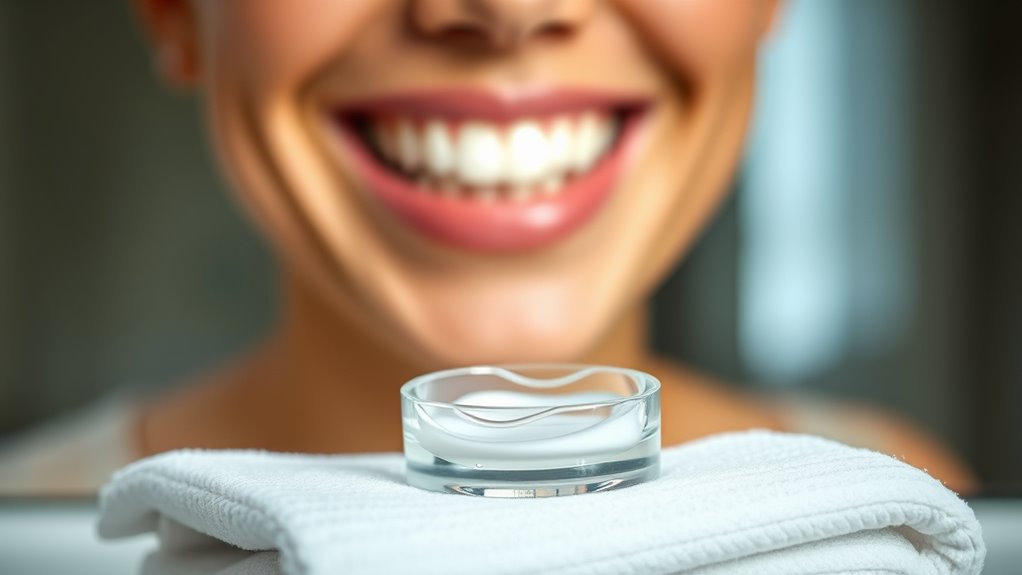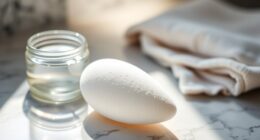To whiten teeth at home without sensitivity, choose products made for sensitive teeth with lower peroxide levels and added desensitizing ingredients like potassium nitrate or fluoride. Apply gels or strips carefully, avoiding contact with gums, and follow instructions precisely. Maintain good oral hygiene, avoid acidic or staining foods, and use gentle, fluoride toothpaste. Spacing out treatments and using desensitizing gels can help prevent discomfort. Discover more tips to brighten your smile safely and comfortably.
Key Takeaways
- Choose gentle whitening products formulated for sensitive teeth with lower peroxide levels and added desensitizing ingredients.
- Follow precise application instructions, avoiding gum contact and overuse to prevent irritation.
- Use desensitizing toothpaste or gels before and after whitening sessions to reduce discomfort.
- Space out treatments with breaks and limit session duration to minimize sensitivity.
- Maintain good oral hygiene, avoid acidic foods, and support enamel health with fluoride or enamel-strengthening products.

If you’re looking for an affordable and convenient way to brighten your smile, at-home teeth whitening offers a practical solution. Many people worry about sensitivity during whitening treatments, but with the right approach, you can achieve a radiant smile without discomfort. The key lies in choosing the right products and following proper procedures to minimize sensitivity while still getting effective results.
Start by selecting a whitening kit designed for sensitive teeth. These often contain lower concentrations of bleaching agents like carbamide peroxide or hydrogen peroxide, which reduces the likelihood of irritation. Look for products that include desensitizing ingredients such as potassium nitrate or fluoride, as these help block nerve pathways and strengthen enamel. Reading reviews and consulting your dentist can guide you to the most suitable options for your needs.
When applying the whitening gel or strips, be precise to avoid excess contact with your gums. Over-application or mishandling can lead to irritation and increased sensitivity. Use the provided applicators carefully, and follow the instructions exactly. If you notice any discomfort, remove the product immediately and rinse your mouth with water. Remember, it’s better to do shorter, more frequent sessions than to overdo it in a single sitting. This approach allows your teeth to gradually whiten without overwhelming your enamel or nerves.
In addition to choosing the right products, maintaining good oral hygiene can noticeably reduce sensitivity. Use a gentle, fluoride-rich toothpaste designed for sensitive teeth. Brushing twice daily and flossing helps keep your enamel healthy, which is essential for minimizing discomfort during whitening. Avoid acidic foods and drinks like citrus or soda, as they weaken enamel and can exacerbate sensitivity. Staying hydrated also helps wash away acids and keeps your mouth balanced, further protecting your teeth.
If sensitivity persists, consider spacing out your whitening sessions or taking breaks between treatments. Applying a desensitizing gel or toothpaste before and after whitening can soothe your teeth and reduce discomfort. Some people find that using a fluoride rinse or gel daily enhances enamel strength, making teeth more resistant to sensitivity. Additionally, enamel strength plays a crucial role in how your teeth respond to whitening procedures. Remember, patience is key—whitening takes time, and rushing the process can lead to unnecessary discomfort.
Ultimately, at-home teeth whitening tailored for sensitive teeth combines careful product selection, precise application, and good oral care habits. By following these guidelines, you can enjoy a brighter smile without the usual sensitivity, making your whitening journey both safe and satisfying.
Frequently Asked Questions
How Long Do At-Home Whitening Results Typically Last?
Your at-home whitening results generally last between three to six months, but this depends on your habits. If you avoid stain-causing foods and drinks, such as coffee, tea, or red wine, and maintain good oral hygiene, your smile stays brighter longer. Touch-up treatments can help extend the results. Regular dental check-ups also support maintaining your whitening, ensuring your teeth stay white and healthy over time.
Are There Specific Ingredients to Avoid for Sensitive Teeth?
Did you know that nearly 40% of people experience increased tooth sensitivity from whitening products? To avoid discomfort, steer clear of ingredients like hydrogen peroxide and carbamide peroxide in high concentrations. Instead, opt for gentler options with aloe vera or potassium nitrate, which help soothe sensitive teeth. Always read labels carefully, and consider consulting your dentist to find the safest, most effective whitening products tailored to your needs.
Can Whitening Products Be Used During Orthodontic Treatment?
You can use whitening products during orthodontic treatment, but it’s best to consult your dentist first. Some products may cause sensitivity or damage your braces or aligners. Look for gentle, enamel-safe options and avoid whitening gels with high peroxide levels. Be cautious around brackets and appliances, as they can interfere with even whitening. Your dentist can recommend safe, effective treatments tailored to your orthodontic needs.
What Are Signs of Adverse Reactions to Whitening Kits?
You might notice signs of adverse reactions like increased tooth sensitivity, gum irritation, or redness after using whitening kits. If your teeth become painfully sensitive or your gums swell or bleed, stop using the product immediately. You could also experience a burning sensation or persistent discomfort. Always follow instructions carefully, and consult your dentist if you notice any of these symptoms or if they worsen, to prevent further issues.
How Often Should I Perform At-Home Whitening Treatments?
You should perform at-home whitening treatments every few months, depending on your teeth and the product’s instructions. Coincidentally, if you’re noticing increased sensitivity or discomfort, it’s a sign to cut back. Typically, wait at least two weeks between treatments to prevent damage. Always follow the specific guidelines provided with your whitening kit, and consult your dentist if you’re unsure about the right frequency for your teeth.
Conclusion
Now that you know the basics of at-home teeth whitening without the sensitivity, you’re all set to boost your confidence and shine brighter. Remember, patience is key—good things come to those who wait, and your radiant smile is worth the effort. Keep consistent, follow the tips, and you’ll see results in no time. Don’t let sensitivity hold you back—you’re in control of your smile’s journey. Keep going, and soon you’ll be grinning from ear to ear!








